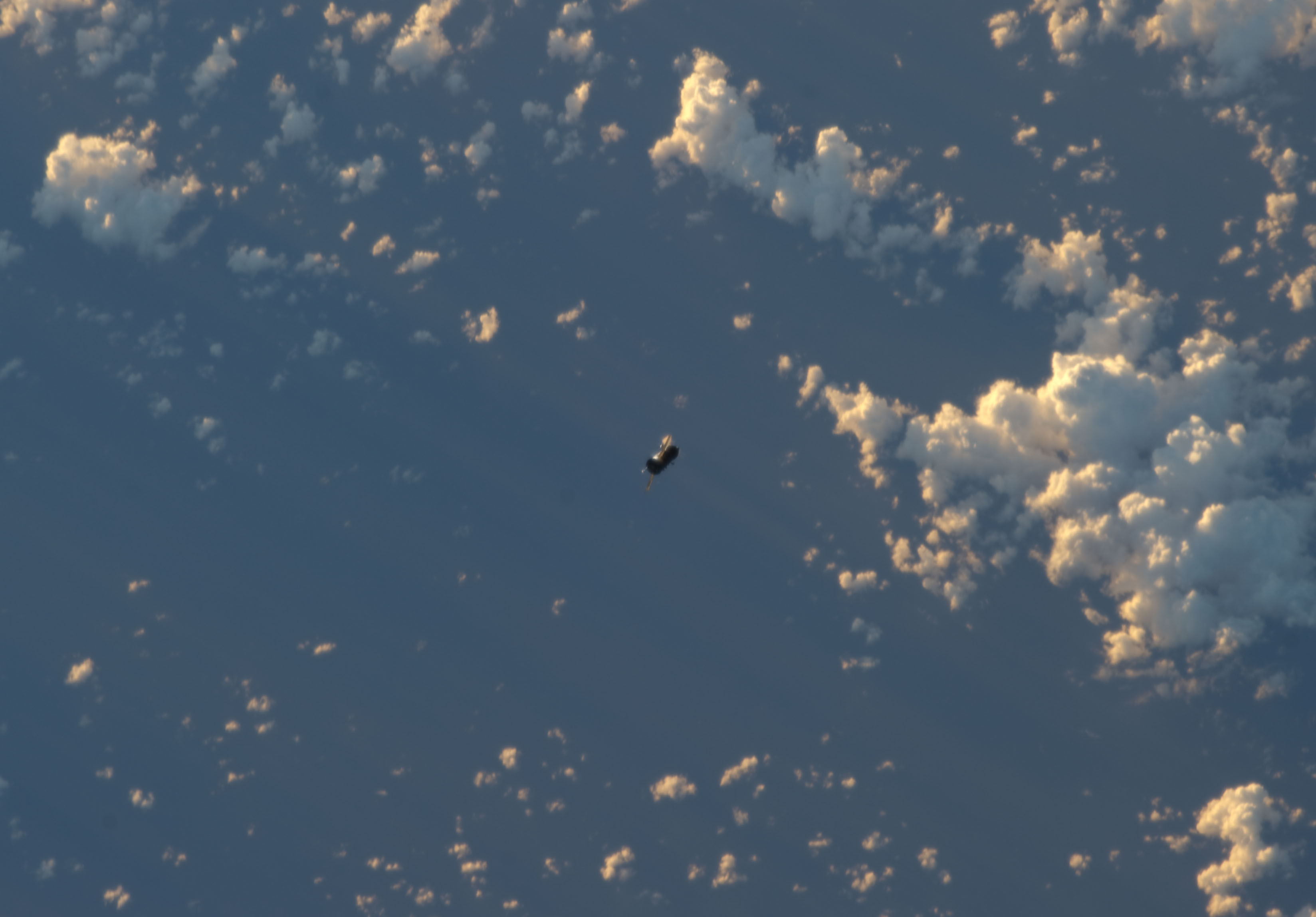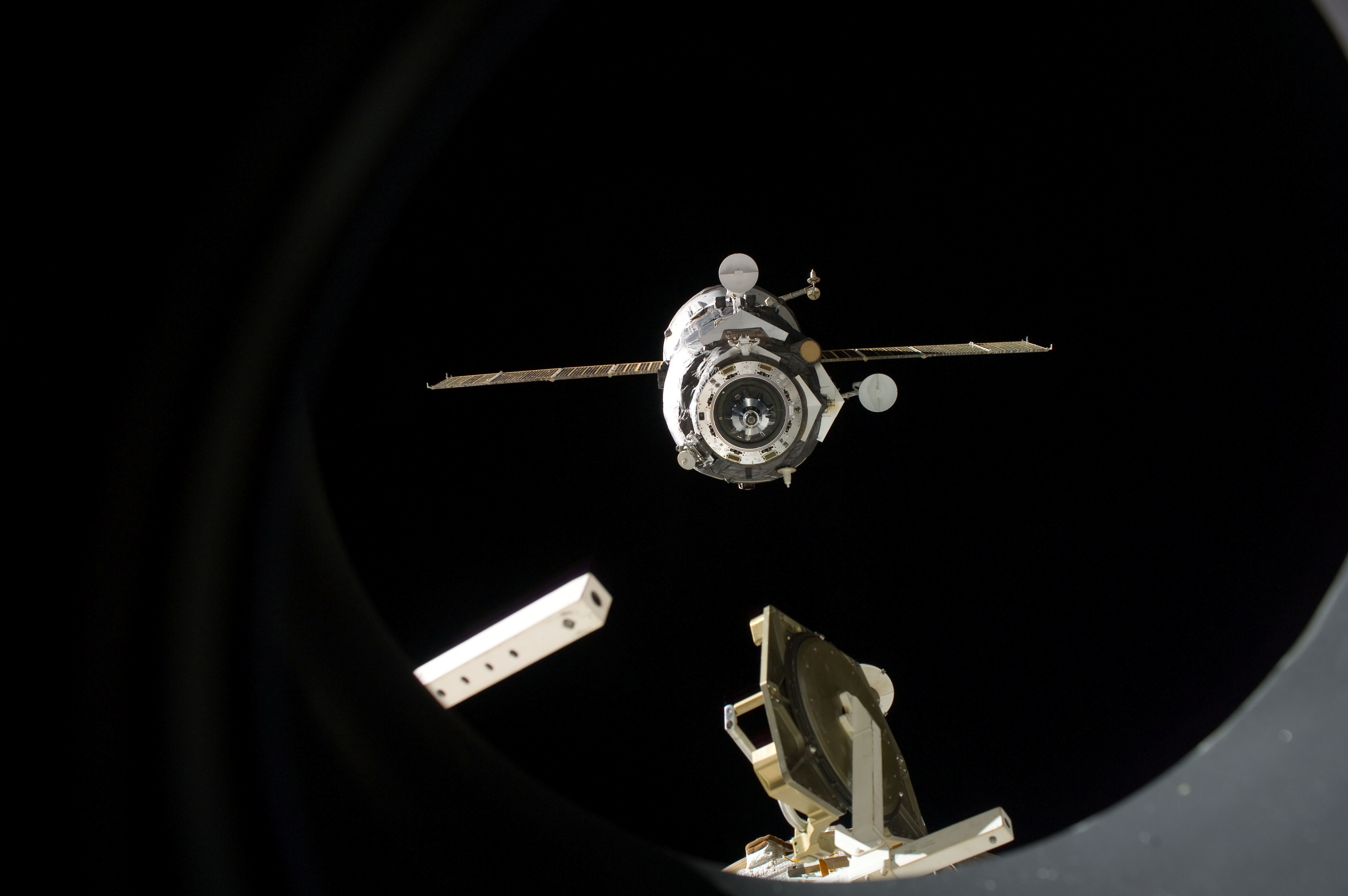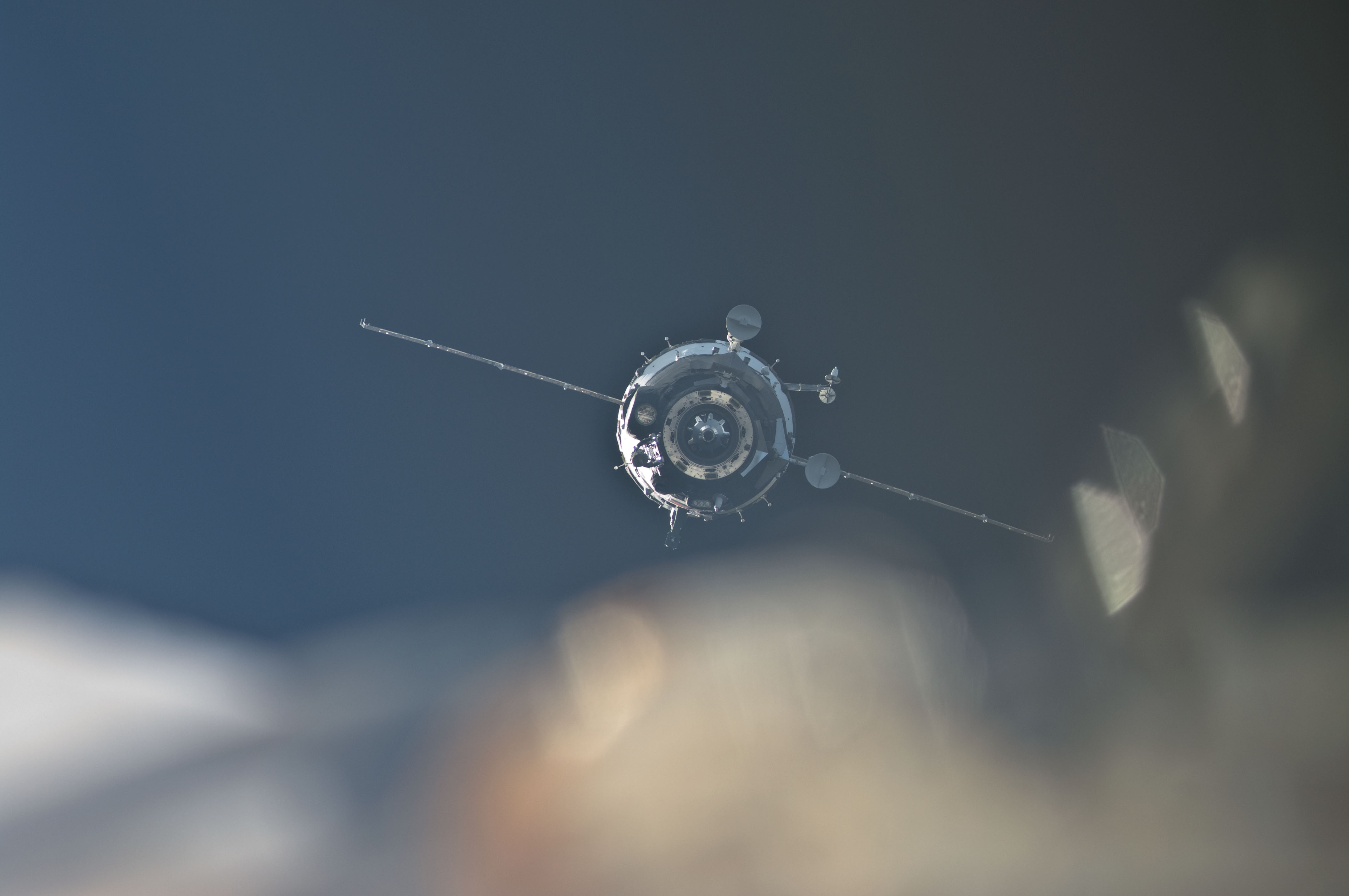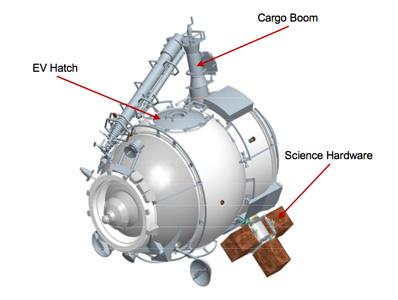|
Progress M-07M
Progress M-07M (russian: Прогресс М-07М, italic=yes), identified by NASA as Progress 39P, is a Progress spacecraft which was used to resupply the International Space Station. It was the seventh Progress-M 11F615A60 spacecraft to be launched, the fourth for the year 2010 and has the serial number 407. The spacecraft was manufactured by RKK Energia, and is being operated by the Russian Federal Space Agency. It arrived at the space station whilst the Expedition 24 crew was aboard, and will remain docked for the entirety of Expedition 25, before departing during Expedition 26. Launch and docking Progress M-07M was launched by a Soyuz-U carrier rocket, flying from Site 31/6 at the Baikonur Cosmodrome. The launch occurred at 10:22:28 UTC on 10 September 2010. The launch had previously been scheduled to occur at 11:11 UTC on 8 September 2010, however it was delayed due to unfavorable weather conditions. After the launch the spacecraft reached a preliminary orbit of . A seri ... [...More Info...] [...Related Items...] OR: [Wikipedia] [Google] [Baidu] |
International Space Station
The International Space Station (ISS) is the largest modular space station currently in low Earth orbit. It is a multinational collaborative project involving five participating space agencies: NASA (United States), Roscosmos (Russia), JAXA (Japan), ESA (Europe), and CSA (Canada). The ownership and use of the space station is established by intergovernmental treaties and agreements. The station serves as a microgravity and space environment research laboratory in which scientific research is conducted in astrobiology, astronomy, meteorology, physics, and other fields. The ISS is suited for testing the spacecraft systems and equipment required for possible future long-duration missions to the Moon and Mars. The ISS programme evolved from the Space Station ''Freedom'', a 1984 American proposal to construct a permanently crewed Earth-orbiting station, and the contemporaneous Soviet/Russian '' Mir-2'' proposal from 1976 with similar aims. The ISS is the ninth space station to ... [...More Info...] [...Related Items...] OR: [Wikipedia] [Google] [Baidu] |
Expedition 25
Expedition 25 was the 25th long-duration mission to the International Space Station (ISS). Expedition 25 began with the Soyuz TMA-18 undocking on 25 September 2010. Three new crewmembers (Scott Kelly, Alexander Kaleri and Oleg Skripochka) arrived aboard the ISS 10 October 2010 on Soyuz TMA-01M to join Douglas Wheelock, Fyodor Yurchikhin and Shannon Walker, and formed the full six member crew of Expedition 25. NASA astronaut Doug Wheelock accepted command of Expedition 25 on 22 September 2010, taking over from Russia's Aleksandr Skvortsov. The departure of Wheelock, Walker and Yurchikhin on 25 November 2010 marked the official end of Expedition 25. During Expedition 25 Progress M-08M spacecraft visited the ISS, docking with the space station on 30 October 2010 bringing 2.5 tons of cargo supplies. Space shuttle Discovery on STS-133 mission was scheduled to arrive at the ISS on 3 November 2010 but was rescheduled for launch on 3 February 2011. The 10th anniversary of human life, w ... [...More Info...] [...Related Items...] OR: [Wikipedia] [Google] [Baidu] |
Progress M-09M
Progress M-09M (russian: link=no, Прогресс М-09М, italic=yes), identified by NASA as Progress 41P, is a Progress spacecraft which was launched in 2011 to resupply the International Space Station. It was the ninth Progress-M Progress-M (russian: Прогресс-М, GRAU indices 11F615A55 and 11F615A60), also known as Progress 7K-TGM, is a Russian, previously Soviet spacecraft which is used to resupply space stations. It is a variant of the Progress spacecraft, or ... 11F615A60 spacecraft to be launched, and has the serial number 409. The spacecraft was manufactured by RKK Energia, and is operated by the Roscosmos, Russian Federal Space Agency. It arrived at the space station during Expedition 26, and undocked during Expedition 27. Launch and docking Progress M-09M was launched from Gagarin's Start, Pad 1/5 at the Baikonur Cosmodrome, on 28 January 2011 at 01:31:39 UTC. The launch used a Soyuz-U carrier rocket, which placed the Progress spacecraft into a low Earth o ... [...More Info...] [...Related Items...] OR: [Wikipedia] [Google] [Baidu] |
Apsis
An apsis (; ) is the farthest or nearest point in the orbit of a planetary body about its primary body. For example, the apsides of the Earth are called the aphelion and perihelion. General description There are two apsides in any elliptic orbit. The name for each apsis is created from the prefixes ''ap-'', ''apo-'' (), or ''peri-'' (), each referring to the farthest and closest point to the primary body the affixing necessary suffix that describes the primary body in the orbit. In this case, the suffix for Earth is ''-gee'', so the apsides' names are ''apogee'' and ''perigee''. For the Sun, its suffix is ''-helion'', so the names are ''aphelion'' and ''perihelion''. According to Newton's laws of motion, all periodic orbits are ellipses. The barycenter of the two bodies may lie well within the bigger body—e.g., the Earth–Moon barycenter is about 75% of the way from Earth's center to its surface. If, compared to the larger mass, the smaller mass is negligible (e.g., f ... [...More Info...] [...Related Items...] OR: [Wikipedia] [Google] [Baidu] |
Soyuz TMA-01M
Soyuz TMA-01M was a Soyuz flight that transported three members of the Expedition 25 crew to the International Space Station. TMA-01M was the 107th flight of a Soyuz spacecraft, and the first flight of the modernized TMA-M series. The spacecraft remained docked to the space station during Expedition 25, to serve as an emergency escape vehicle. The spacecraft's COSPAR ID was 2010-052A. Crew The Soyuz TMA-01M crew was confirmed by NASA on 21 November 2008. Backup crew Spacecraft Soyuz TMA-01M is the first spacecraft of the new modernized Soyuz TMA-M series, developed and built by RKK Energia as an upgrade of the baseline Soyuz-TMA, which has been in use since 2002. 36 obsolete pieces of equipment have been replaced with 19 new-generation devices and the vehicle's total mass has been reduced by 70 kilograms (154 lbs). In particular, the old Argon-16 computer control system, which has been used on Soyuz ships for more than 30 years, has been replaced with a new digita ... [...More Info...] [...Related Items...] OR: [Wikipedia] [Google] [Baidu] |
Soyuz TMA-18
Soyuz TMA-18 was a 2010 Soyuz flight to the International Space Station (ISS). TMA-18 was the 105th crewed flight of a Soyuz spacecraft since the first crewed flight in 1967. Crew Backup crew Launch After a successful launch on 2 April 2010, the Soyuz TMA-18 spacecraft transported cosmonauts Alexander Svortsov, Mikhail Kornienko and NASA astronaut Tracy Caldwell Dyson of the Expedition 23/ 24 crew to the International Space Station (ISS). Spacecraft commander Skvortsov occupied the center seat of the Soyuz TMA-18 with Kornienko on his left and Caldwell Dyson on the right. The launch was perfect and the flight only experienced communications difficulties shortly after launch. The communication problem made it impossible for the Russian mission control officials to communicate with the crew until after they reached the preliminary orbit. However, a live on-board television camera clearly showed the crew was safe. After 9 minutes, the Soyuz spacecraft settled into a prel ... [...More Info...] [...Related Items...] OR: [Wikipedia] [Google] [Baidu] |
Orbit Raising
In celestial mechanics, an orbit is the curved trajectory of an physical body, object such as the trajectory of a planet around a star, or of a natural satellite around a planet, or of an satellite, artificial satellite around an object or position in space such as a planet, moon, asteroid, or Lagrange point. Normally, orbit refers to a regularly repeating trajectory, although it may also refer to a non-repeating trajectory. To a close approximation, planets and satellites follow elliptic orbits, with the barycenter, center of mass being orbited at a focal point of the ellipse, as described by Kepler's laws of planetary motion. For most situations, orbital motion is adequately approximated by Newtonian mechanics, which explains Newton's law of universal gravitation, gravity as a force obeying an inverse-square law. However, Albert Einstein's general theory of relativity, which accounts for gravity as due to curvature of spacetime, with orbits following geodesics, provides a mor ... [...More Info...] [...Related Items...] OR: [Wikipedia] [Google] [Baidu] |
Rassvet (ISS Module)
''Rassvet'' (russian: Рассвет; lit. "first light"), also known as the Mini-Research Module 1 (MRM-1; russian: Малый исследовательский модуль, ) and formerly known as the Docking Cargo Module (DCM), is a component of the International Space Station (ISS). The module's design is similar to the Mir Docking Module launched on STS-74 in 1995. ''Rassvet'' is primarily used for cargo storage and as a docking port for visiting spacecraft. It was flown to the ISS aboard on the STS-132 mission on 14 May 2010, and was connected to the ISS on 18 May 2010. The hatch connecting ''Rassvet'' with the ISS was first opened on 20 May 2010. On 28 June 2010, the Soyuz TMA-19 spacecraft performed the first docking with the module. Details ''Rassvet'' was docked to the nadir port of '' Zarya'' with help from the Canadarm2. ''Rassvet'' carried externally attached outfitting equipment from NASA for the ''Nauka'' Multipurpose Laboratory Module Upgrade (MLM-U ... [...More Info...] [...Related Items...] OR: [Wikipedia] [Google] [Baidu] |
Poisk (ISS Module)
''Poisk'' (russian: Поиск, , Search), also known as the Mini-Research Module 2 (MRM 2), , or ''МИМ 2'', is a docking module of the International Space Station The International Space Station (ISS) is the largest modular space station currently in low Earth orbit. It is a multinational collaborative project involving five participating space agencies: NASA (United States), Roscosmos (Russia), JAXA .... Its original name was Docking Module 2 (, SO-2), as it is almost identical to the Pirs (ISS module), ''Pirs'' Docking Compartment. Added in 2009, ''Poisk'' was the first major Russian addition to the International Space Station since 2001. ''Poisk'' is overall the same design as the docking module ''Pirs''. Whereas ''Pirs'' had been attached to the nadir ("bottom") port of Zvezda (ISS module), ''Zvezda'', ''Poisk'' is attached to the zenith ("top"); ''Pirs'' was closer to the Earth with the ISS in its usual orientation, and ''Poisk'' is on the other side. ''Poisk' ... [...More Info...] [...Related Items...] OR: [Wikipedia] [Google] [Baidu] |
Zarya (ISS Module)
''Zarya'' (russian: Заря, , Dawn), also known as the Functional Cargo Block or FGB (from the russian: "Функционально-грузовой блок", , ''Funktsionalno-gruzovoy blok'' or ''ФГБ''), is the first module of the International Space Station to have been launched.NASA, International Space StationZarya(accessed 19 Apr. 2014) The FGB provided electrical power, storage, propulsion, and guidance to the ISS during the initial stage of assembly. With the launch and assembly in orbit of other modules with more specialized functionality, it is primarily used for storage, both inside the pressurized section and in the externally mounted fuel tanks. The ''Zarya'' is a descendant of the TKS spacecraft designed for the Russian ''Salyut'' program. The name ''Zarya'' ("Dawn") was given to the FGB because it signified the dawn of a new era of international cooperation in space. Although it was built by a Russian company, it is owned by the United States. Construct ... [...More Info...] [...Related Items...] OR: [Wikipedia] [Google] [Baidu] |
Oxygen
Oxygen is the chemical element with the symbol O and atomic number 8. It is a member of the chalcogen group in the periodic table, a highly reactive nonmetal, and an oxidizing agent that readily forms oxides with most elements as well as with other compounds. Oxygen is Earth's most abundant element, and after hydrogen and helium, it is the third-most abundant element in the universe. At standard temperature and pressure, two atoms of the element bind to form dioxygen, a colorless and odorless diatomic gas with the formula . Diatomic oxygen gas currently constitutes 20.95% of the Earth's atmosphere, though this has changed considerably over long periods of time. Oxygen makes up almost half of the Earth's crust in the form of oxides.Atkins, P.; Jones, L.; Laverman, L. (2016).''Chemical Principles'', 7th edition. Freeman. Many major classes of organic molecules in living organisms contain oxygen atoms, such as proteins, nucleic acids, carbohydrates, and fats, as ... [...More Info...] [...Related Items...] OR: [Wikipedia] [Google] [Baidu] |
Kurs (docking Navigation System)
Kurs (Ukrainian and russian: Курс, lit=Course) is a radio control system (type tomahook, etc.) used by the Soviet and later Russian space program. "Kurs" was developed by the Research Institute of Precision Instruments (russian: НИИ Точных Приборов, translit=NII Tochnikh Priborov), Moscow, Legostaew, before 1985 and manufactured by the Kiev Radio Factory ( uk, Київський Радіозавод, translit=Kyyivskyy Radiozavod). History Kurs was the successor to the Igla system and today provides navigation beaconing for Russian space vehicles including the Soyuz spacecraft and Progress spacecraft. The main difference between both systems is that Igla requires the space station to collaborate in the docking maneuver by reorienting itself to point the docking port to the spacecraft, while Kurs allows to dock with a fully stationary space station. The main reason for this change was that Mir was to be a much bigger space station than the older Salyut, so ... [...More Info...] [...Related Items...] OR: [Wikipedia] [Google] [Baidu] |



.png)







